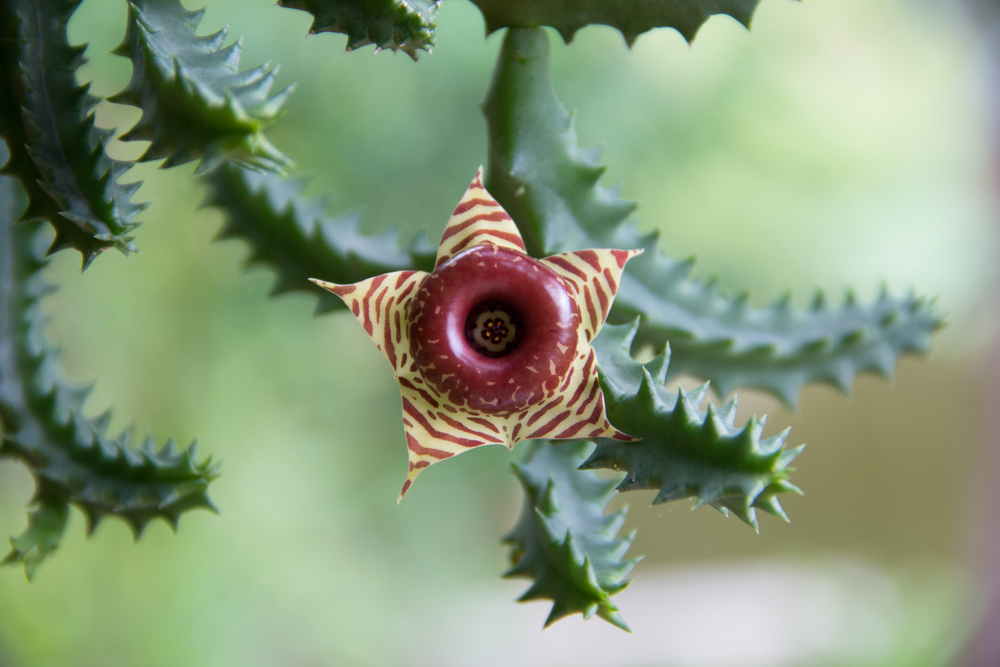We’re pretty sure we’ve seen this plant in a sci-fi movie, but now we want it in our homes. This little cactus is unique and adorable, and rather creepy! Known best for its Lifesaver candy-shaped flowers, this cactus is ideal for those looking for a plant with limited space. If nothing else, you’re sure to have an excellent conversation starter in your home if you add this cactus to your collection.
Ensure you’re caring for this remarkable little plant the best way you can by reading on about what this plant is and how to best water it, provide it with enough light, feed it, keep it happy with its preferred temperatures, and keep it out of reach of kids and pets.

What is a lifesaver plant?
Native to southern Africa, the lifesaver plant gets its name from the shape of its unusual blooms, which literally look like Lifesaver candy. It’s also known as lifebuoy hernia, little owl eyes, and carrion flower. While these names don’t conjure cute or friendly images, we’re sure you’ll want one as soon as you see one.
Although the flowers are cute, we must warn you that they emit a terrible odor that resembles the smell of dead flesh. And unfortunately, unlike other cactus, the lifesaver plant isn’t shy about producing these unique yet pungent flowers. So if the smell bothers you, it might be best to keep it in a room you don’t frequent or outdoors if your climate permits.
It’s great for smaller spaces too, as it only gets about six inches wide and six to eight inches tall.
So the blooms of this plant might take the attention for the most part, but even when not in bloom, this cactus is adorable with light green stems and cute little spikes.

Care tips for a lifesaver plant
Okay, so either you’re now obsessed with this plant, and you need to have one for yourself, or you’re not interested. If you’re on board, you’re going to want to care for this plant in the best way you can so it doesn’t die. Below are the tips we’ve found that keep a lifesaver plant happy, healthy, and eagerly pushing out more flowers.
Water
This plant is a cactus, and like all cacti, it doesn’t like water to sit in its soil or around its roots. Therefore, it’s best to water this plant infrequently and allow the soil to dry out completely in between watering. You’ll want to plant it in well-draining soil, too, so there’s less risk of root rot. We also recommend using a terracotta pot where the water can dry out quickly. When you do water your lifesaver plant, you’ll want to do it thoroughly. Let the water completely drain through and wait for it to stop draining before placing it back on its saucer.
Light
In its natural habitat, this little cactus grows in the shade of other larger cactus. So while it’s like its cousins in the water area, it’s not so fond of full sun. The lifesaver plant would rather have partial shade and might even struggle to stay alive if placed in direct sunlight. If it’s getting too much sun, the green parts of the plant will turn a bright red. It’s almost like it’s getting a sunburn!
Food
As usual with indoor house plants, fertilize the lifesaver plant once a month during the heavy growing seasons of spring and summer, then not at all during the fall and winter.
Temperature
As long as temperatures stay above 50, this little plant can handle it, so the average temperature of a home (65 to 75 degrees) is perfectly safe. Just be sure to bring your cactus indoors if it lives outside during the warmer months.
Toxicity
The lifesaver plant is toxic to both pets and humans, so be sure to keep it out of reach on a high shelf or in a room where pets and kids aren’t allowed.
Maybe you’ve never heard of the lifesaver plant, or perhaps you’ve been tracking one down and you finally got your hand on one; either way, these are the best ways to care for it so it can live its best life. Remember to use well-draining soil, don’t water too much, and avoid direct sunlight.


